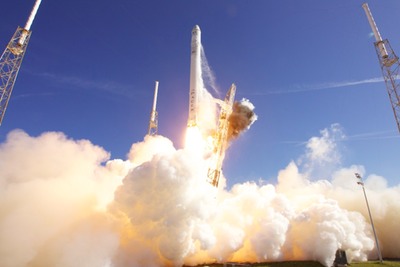Commercial space and the mediaby Anthony Young
|
| Those of us who write about space launch activities, either history or the present age, appreciate the real significance of this flight even if the media does not. |
There are no doubt many readers of The Space Review who were not even born when Project Apollo initially gripped the world’s attention—at least in the early years of the missions to the Moon. The apex of media interest was the first Moon landing, Apollo 11. But as early as Apollo 13, the media seemed to feel the third manned launch to the Moon was a non-event. This fact is depicted in a brief scene years later in the movie Apollo 13. That all changed when a cryogenic oxygen tank exploded in the service module, putting that crew at grave risk. Suddenly Apollo 13 was the biggest news item in the world and remained that way until their capsule safely splashed down in the Pacific.
When the shuttle flights cease in 2011, it will be years before astronauts will once again be launched from the United States. American astronauts will fly to Russia and be launched aboard Soyuz rockets—and it is doubtful American media will go there to cover those launches; they don’t do that now.
To explain the media’s almost total lack of interest in the Falcon/Dragon mission, I would like to draw a parallel. When Charles Lindbergh flew from Roosevelt Field on Long Island, New York, to Paris in May 1923 to win the Orteig Prize, his perilous but successful flight, much like Apollo 11, was the news sensation of its day. In the decades that followed, trans-Atlantic flights became routine and were not newsworthy. Commercial flight with passengers—which Lindbergh tirelessly promoted—between the United States and Europe became a dream realized, and the advent of jet flight dramatically shortened flight time. Most significantly, the element of danger was removed.
Of course, no astronauts were aboard the Falcon/Dragon flight. For the media, it was just another rocket launched like many hundreds of others launched before it. The significance of it was that this was a commercial flight as part of NASA’s Commercial Orbital Transportation Services (COTS) program and it was stunning success apparently without a single anomaly. SpaceX CEO Elon Musk was so astounded by the entire mission’s success that in the press conference remarks he admitted he wished he could be more articulate, “but it’s hard to be articulate when your mind is blown.”
Those of us who write about space launch activities, either history or the present age, appreciate the real significance of this flight even if the media does not. It is true this was not a completely privately-funded launch vehicle and mission. In part, it was underwritten and managed by NASA’s COTS program. Nevertheless, this paves the way for commercial human missions. If one looks at an array of former government-run programs that transitioned to the private sector, one has to believe commercial space exploration and providing of services to the government instead of by the government is in the not too distant future.
For many individuals like myself who have expressed dismay over the winding down of the shuttle program and the battle over how best to proceed with human spaceflight efforts by NASA, the significance of the SpaceX launch on December 8th will be remembered as the dawn of a new space age and that the future is indeed bright for the United States. And, I have no doubt that when a crew of astronauts strap themselves into the their couches aboard a future Dragon capsule in what will hopefully be only a few years, that day will witness a sea of reporters at the Cape to record that historic launch.
